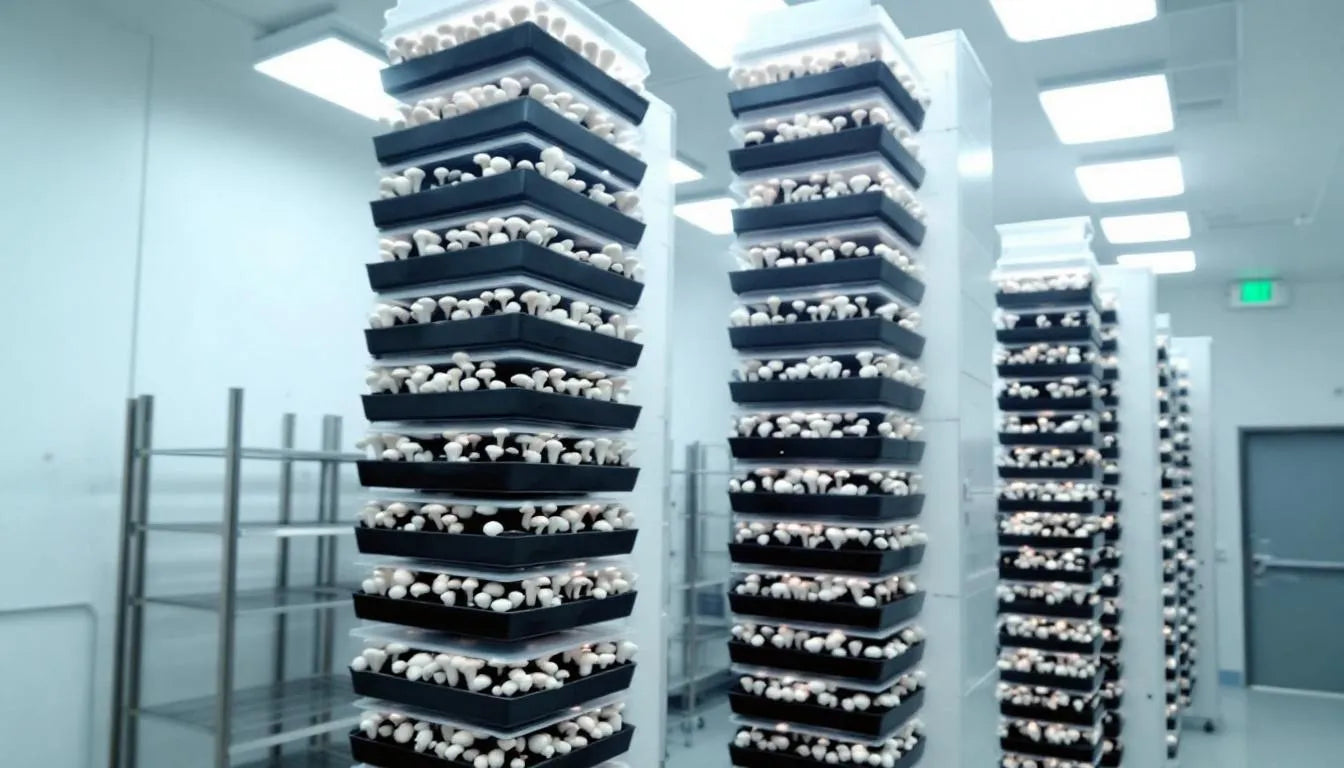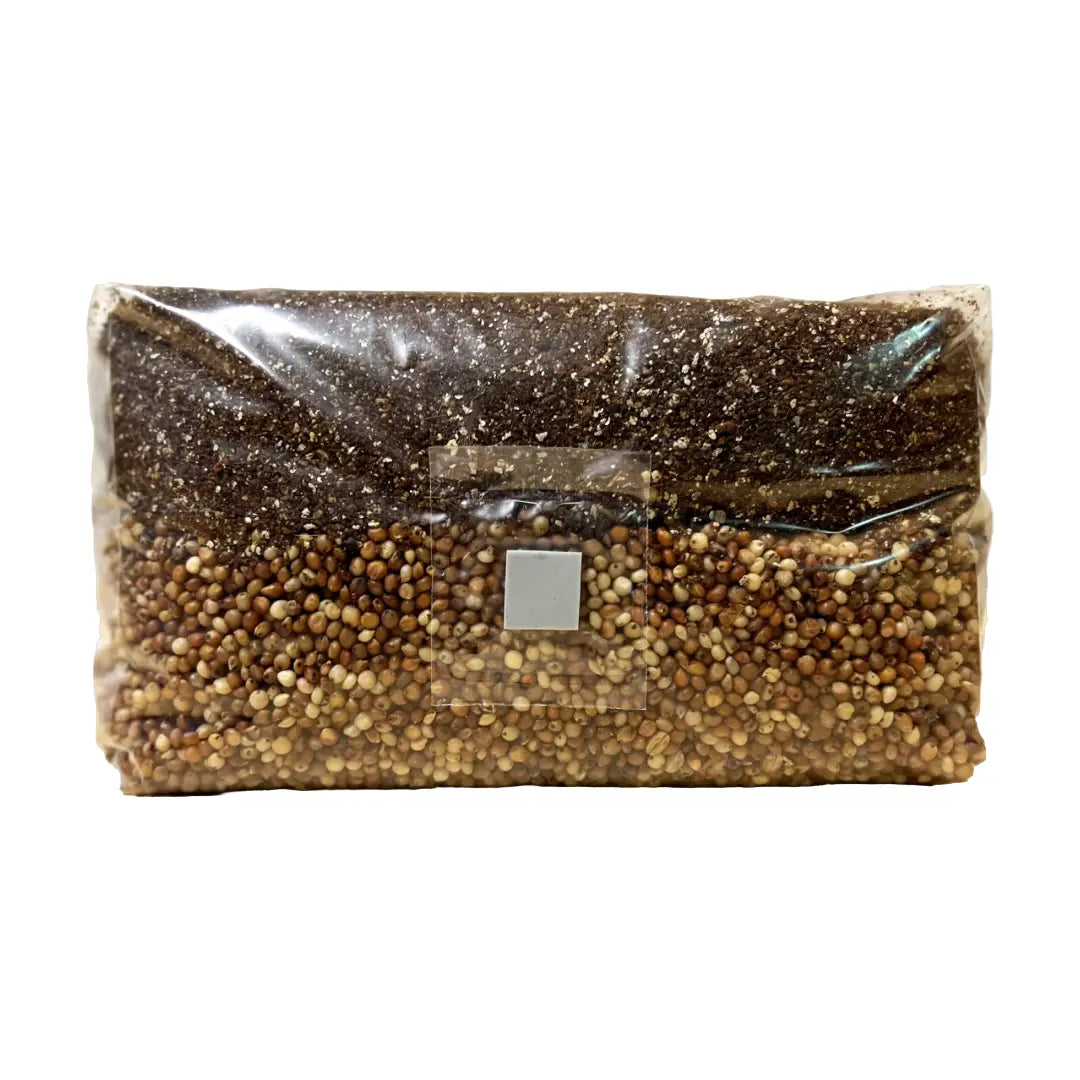⬇️ Prefer to listen instead? ⬇️

- Vertical mushroom farming yields up to 4x more than traditional flat-bed methods.
- Mushroom towers reduce water usage by up to 75%, requiring as little as 1.2 liters per kg.
- Towers allow weekly, year-round harvests—even when winters are harsh.
- Mushroom tower systems can be installed indoors, outdoors, or on rooftops—ideal for urban growers.
- Specialty mushrooms like lion’s mane can sell for $35/kg with minimal cost and space.
If you’ve ever dreamed of growing your own gourmet mushrooms but thought you didn’t have the space, mushroom towers may be the solution. These vertical farming systems can yield up to 10 kilograms of mushrooms per square meter weekly, making them a highly efficient option for home growers. Whether you’re working with a small balcony, a spare corner in your garage, or a backyard greenhouse, mushroom towers offer space-saving, sustainable food production right at home. For a simpler alternative to towers, our monotubs make indoor mushroom cultivation easy, efficient, and highly productive — perfect for growers who want big harvests without complex setups.

What Is a Mushroom Tower System?
A mushroom tower is a type of vertical mushroom farming system that uses the principles of vertical agriculture to maximize yield per square meter. Instead of growing mushrooms horizontally on flat beds or trays, these systems use vertical stacking—imagine shelves loaded with mushroom substrate or a cylindrical column packed with layers of inoculated growing media. This not only multiplies the growing surface area but also lets people use small or underutilized spaces.
Vertical mushroom farming through towers takes many shapes and forms, including:
- Outdoor straw towers: Constructed with hog wire or chicken wire filled with pasteurized straw, these are ideal for seasonal, low-tech, outdoor mushroom cultivation.
- Indoor towers where you control the conditions: These units maintain optimal conditions (temp, humidity, carbon dioxide) for year-round indoor production.
- Hydroponic-inspired smart towers: Advanced systems use IoT-based sensors, controls, and sometimes artificial intelligence to automate most aspects of cultivation.
By dramatically increasing surface area, mushroom towers can get yields from 6.5–10 kg/m² per week—compared to 2–3 kg/m² with conventional methods. This yield advantage makes mushroom towers an especially appealing option for urban farming, homesteading, or small-scale commercial production.

Why Vertical Mushroom Farming Makes Sense at Home
The concept of vertical mushroom farming isn’t just for large-scale urban farms with industrial budgets. For everyday people looking to grow food at home, mushroom towers offer unmatched efficiency, flexibility, and sustainability.
High Yields in Tiny Spaces
One of the most attractive features of mushroom towers is their footprint-to-yield ratio. You can fit a functional growing system into a tiny footprint—sometimes as small as 2 square feet. This compact size is especially handy for:
- Apartment dwellers with balconies
- Urban rooftop gardeners
- Homeowners with limited backyard space
In practical terms, a small vertical system can yield more mushrooms weekly than a sprawling, non-tiered setup.
Scalable and Modular
Start small and scale as you go. You can start with one tower and add more later as your experience and confidence grow. Modular components—such as stackable buckets, grow bags, or wired cage structures—make it easy to expand.
Environmental Efficiency
Mushrooms are already recognized as one of the most water-efficient and low-emission crops. Vertical farming makes that even better by improving:
- Water efficiency: Towers require as little as 1.2 liters of water per kg grown—significantly less than leafy greens or root vegetables.
- How well you can control conditions: It’s easier to insulate and control the conditions within a tower than a larger horizontal spread.
- Material efficiency: Towers can be built from low-cost or recycled materials, increasing sustainability while reducing waste.
Technology Integration for Minimal Labor
IoT-integrated towers can alert you when:
- Humidity drops below target
- CO₂ levels spike above recommended limits
- Temperature causes stress to the mycelium or fruiting bodies
Automation can further reduce manual labor, especially when paired with remote monitoring apps or smart home integrations.

Substrate Selection and Preparation for Towers
The success of your vertical mushroom farm begins with choosing the right substrate. Different species of mushrooms require different nutritional environments, and substrate preparation plays a crucial role in both yield and contamination prevention.
Common Substrate Types
- Straw: Affordable and widely available. Best for oyster mushrooms and other fast-growing species.
- Hardwood sawdust: Ideal for shiitake, lion’s mane, and king oyster.
- Coffee grounds: A nutrient-rich, upcycled choice perfect for urban growers.
- Coco coir and soy hull blends: Great for commercial-grade yield consistency.
Recommended Substrate by Mushroom Type
| Mushroom Type | Ideal Substrate |
|---|---|
| Oyster | Straw, coffee grounds, cardboard |
| Shiitake | Hardwood sawdust + wheat bran |
| Lion's Mane | Hardwood + nitrogen supplementation |
| King Oyster | Sawdust + grain hulls or enriched mix |
Sterilization or Pasteurization
Sterilization is essential to prevent contamination from competing fungi or pathogens. Depending on your substrate:
- Boil straw or cardboard for 10–15 minutes in water.
- Pressure cook sawdust substrates at 15 PSI for 90 minutes.
Moisture level is key: the "squeeze test" ensures proper hydration. Squeeze a handful of substrate—just a few drops of water should emerge.
Sterilize your growing containers, gloves, and tools with 70% isopropyl alcohol before use. Working in a clean space—even a DIY flow hood or glove box—can really improve success rates.

Optimal Environmental Conditions for Tower Cultivation
Mushrooms are sensitive organisms. They respond directly to environmental stimuli during spread (colonization) and fruiting phases. Failure to meet parameters often results in stunted growth, contamination, or no yield.
Temperature Ranges
| Mushroom | Colonization Temp | Fruiting Temp |
|---|---|---|
| Oyster | 75°F (24°C) | 64°F (18°C) |
| Shiitake | 77°F (25°C) | 61°F (16°C) |
| Lion’s Mane | 72–75°F | 60–65°F |
Different growth phases need specific temperatures. Colonization benefits from warmth, while fruiting prefers cooler conditions.
Humidity Control
- Range: 80–95% RH during fruiting.
- Tools: Ultrasonic humidifiers, misters, or even damp towels for small setups.
- Warning signs: Dry caps or blue discoloration = too dry. Mushy or moldy structures = too humid.
CO₂ and Ventilation
-
CO₂ Targets:
- Colonization phase: Up to 5,000 ppm (low airflow)
- Fruiting phase: 800–1,200 ppm (high airflow)
Use inline fans or ducted blowers to drive stale air out and bring fresh air in. For small systems, even a USB-powered fan can suffice.

Step-by-Step: How to Build Your Own Mushroom Tower
Making your own mushroom tower can be an affordable and rewarding DIY project. Depending on your skill level, you can keep it basic or integrate tech.
Materials Checklist
- Wire mesh cylinder or PVC tubing
- Cardboard or landscape fabric (for base)
- Sterilized substrate (enough to fill structure)
- Mushroom spawn (20% by volume)
- Plastic sheet (humidity tent or top seal)
- Zip ties or fasteners
- Optional: small fan, humidity sensors, lighting
Construction Steps
- Frame Assembly: Wrap wire mesh into a tube 3–4 feet tall; secure with ties.
- Base Preparation: Lay cardboard or landscape fabric to act as a fungal barrier.
- Layering: Add 6 inches of moist substrate, then sprinkle spawn. Alternate up to the top.
- Seal the Tower: Add plastic over the top and sides to create a high-humidity chamber.
- Colonization Phase: Keep in a warm, dark environment for 10–21 days.
- Fruiting Phase: Once white mycelium fully colonizes, expose to light and fresh air.

Best Mushrooms to Grow in Towers
Some mushrooms perform better in vertical farming setups because of their natural growth habits, yield potential, and environmental adaptability.
Top Picks for Mushroom Towers
| Mushroom | Characteristics | Yield (kg/m²/wk) | Market Price/kg |
|---|---|---|---|
| Oyster | Fast-growing, ideal for beginners | 6–7.8 | $8–$15 |
| Shiitake | Slower maturity, rich flavor | 3–4 | $25 |
| Lion’s Mane | Brain-boosting medicinal benefits | ~3.5 | $30–$35 |
| King Oyster | Meaty stems, long shelf life | ~5.8 | $12–$18 |
| Wine Cap | Resilient outdoor mushroom | 4.8 | $10 |
Oyster mushrooms remain the top choice for newcomers due to their forgiving nature and impressive yields. Once you gain confidence, expand into gourmet or medicinal species with higher profit potential.

Equipment and Infrastructure Overview
Even basic mushroom towers require essential environmental controls for consistent yields. Fortunately, home-scale systems need only lightweight gear.
Core Components
- Ventilation Fans: Circulate fresh air; use inline or clip-on models.
- Humidifiers: Ultrasonic or cool mist humidifiers maintain RH.
- Lighting: LED or CFL bulbs on a 12hr light/12hr dark schedule.
- Sensors: Track temperature, RH, and CO₂. Connect to Wi-Fi-enabled hubs if desired.
Optional Upgrades
- Timers & Controllers: Automate mist cycles and fan operation.
- AI Systems: Expensive but reduce labor and decision-making.
- Grow Tents: Offer containment, light control, and temperature stability.
Modular towers integrate well with standard hydroponic or vertical farming infrastructure—making crossover adoption feasible if you already grow plants.

Costs and Economic Benefits
Mushroom towers can range from shoestring DIY builds to high-end automated systems. While home growers may pursue towers for self-reliance or hobby purposes, even small setups show strong economic performance.
Sample Budget Analysis
| Item | Estimated Cost |
|---|---|
| Tower materials | $50–$200 |
| Substrate + spawn | $40/month |
| Humidifier + fan | $80–$300 |
| Sensors | $30–$100 |
| Total Setup (basic) | ~$200–$500 |
Advanced indoor systems with automation can cost $10,000+, but can produce up to 1,380 kg of mushrooms annually. At retail prices between $10–$35/kg, this means a potential revenue of over $48,000/year—excluding labor.
DIY home growers can expect a return-on-investment in less than 6 months depending on output.

Troubleshooting Common Issues
New growers often encounter challenges. Identifying issues early can save your harvest.
| Issue | Symptom | Solution |
|---|---|---|
| Contamination | Green, black, or pink growth | Remove infected substrate, sanitize tools |
| Low Humidity | Crackled caps, slow growth | Increase misting; cover sides with plastic |
| High Humidity | Slimy mushrooms, mold spread | Improve airflow; reduce misting frequency |
| Low Spawn Ratio | Patchy colonization, slow growth | Use 20% spawn to substrate for best coverage |
| CO₂ Buildup | Long stems, tiny caps (“fuzzy feet”) | Improve air exchange with more ventilation |
Daily observation for discoloration, odor, or growth abnormalities is key to catching problems early.

How Mushroom Towers Support Sustainability
Vertical mushroom farming contributes to a circular economy and a greener planet.
- Low Carbon Footprint: Unlike livestock, mushrooms emit minimal methane or CO₂.
- Low Water Use: Mushrooms need <2 gallons of water per pound produced.
- Waste Recycling: Use brewery grains, coffee grounds, or cardboard as substrates.
- Minimal Land Use: Tower systems need just a few feet of horizontal space.
- Organic Waste Conversion: Spent substrate becomes compost or animal feed.
For eco-conscious consumers, growing mushrooms using towers is a hands-on way to live out sustainable values.

The Future of Mushroom Tower Farming
As urban agriculture grows, mushroom tower design is changing fast.
- Smart towers: AI-driven systems adjust airflow, CO₂, humidity, and even predict harvest dates.
- Urban integration: Rooftop and basement farms are repurposing unused city infrastructure into food-growing hubs.
- Educational tools: Mushroom towers are entering classrooms, helping kids learn regenerative agriculture.
- Global scalability: From Nairobi to New York, tower farms are answering food security issues in dense urban areas.
It’s likely that mushroom towers will play a permanent role in the decentralized food networks of tomorrow.

FAQs About Home Mushroom Towers
Q: How much space do I need to start?
A: As little as 2 square feet; even small closets can host a productive tower.
Q: When can I harvest my first batch?
A: Oyster mushrooms fruit in as little as 10–14 days; others like shiitake take 45–60 days.
Q: Are mushroom towers safe indoors?
A: Yes, as long as proper humidity and air exchange are maintained.
Q: Can kids and pets be around mushroom towers?
A: Yes, but avoid toxic wild species; stick with cultivated, edible types.
Q: Are there kits for beginners?
A: Several retailers offer starter kits for vertical mushroom farming—easy to use and affordable.
Who Should Try Growing in Mushroom Towers?
Whether you're an aspiring urban farmer, sustainability advocate, or someone with a taste for gourmet fungi, mushroom towers offer a practical and rewarding path into mushroom cultivation. With minimal space, low water use, and the potential for high yields, vertical mushroom farming is accessible to nearly everyone. Start small, learn the basics, and discover the pleasure (and profit) of growing your own mushrooms at home.
Resources and Next Steps
-
Books:
- "The Mushroom Cultivator" by Paul Stamets
- "Organic Mushroom Farming and Mycoremediation" by Tradd Cotter
-
Helpful Associations:
Your best next move? Build a test tower using locally available materials, document your progress, and join a growing community of vertical mushroom farmers.



